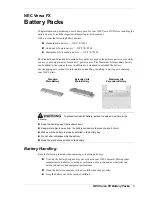
LEAB Automotive -CPC
LEAB Automotive GmbH
Page - 7 -
2.3
Connection
If you want to use the LEAB CPC as a mobile battery charger, please continue with section 2.3.2.
2.3.1 Battery in the vehicle
Connect the two charging cables fixed to the LEAB CPC as follows:
red end of the cable to the plus terminal of the battery ()
black end of the cable to the minus terminal of the battery (marked –) or an earth contact point
provided near the battery.
We recommend the use of a safety fuse in the plus cable with the following values:
Type
CPC 1215
CPC 1220
CPC 1230
CPC 2415
CPC 2420
Fuse
30 A
40 A
50 A
30 A
40 A
Cross-
section
6 mm²
6 mm²
6 mm²
6 mm²
6 mm²
Type
CPC 2430
CPC 1260
CPC 2440
CPC 2450
CPC 2460
Fuse
50 A
75 A
75 A
75 A
75 A
Cross-
section
6 mm²
10 mm²
10 mm²
10 mm²
10 mm²
The cross-sections of the charging cables must not be reduced. We recommend keeping the charging
cables as short as possible and not extending them.
There are three sockets on the back of the CPC
battery charger (only 2 sockets on the CPC
1600W) which can be used to connect additional
devices (see section 4.6ff). Assignment is as
follows:
2.3.2 Battery outside the vehicle
Connect the two charging cables to the battery terminals as follows:
red end of the cable to the plus terminal of the battery ().
blue end of the cable to the minus terminal of the battery (marked –).
Only use suitable battery terminal clamps and protective pole caps such as the ones you can find in our
range at http://shop.leab.eu.
230V mains connection
There is a connection socket for the 230V mains cable on the back of the CPC battery charger. The plug
system of the type Neutrik can be locked, thus guaranteeing safe and vibration-resistant contact in
every vehicle, yet providing maximum flexibility during installation and removal. Please refer to Annex A
Remote display
Temperature/voltage sensor
CBL relay (not CPC 1600W)
All manuals and user guides at all-guides.com








































